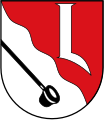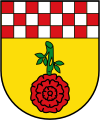Blankenstein (Hattingen)
|
Blankenstein (Hattingen)
City of Hattingen
|
||
|---|---|---|
| Coordinates: 51 ° 24 ′ 23 " N , 7 ° 13 ′ 39" E | ||
| Residents : | 2743 (Dec. 31, 2014) | |
| Incorporation : | January 1, 1970 | |
| Postal code : | 45527 | |
| Area code : | 02324 | |
|
Location of Blankenstein (Hattingen) in North Rhine-Westphalia |
||
|
View of the village of Blankenstein
|
||
Blankenstein , formerly Blankenstein / Ruhr , is a former town in the Ennepe-Ruhr district and today a district of Hattingen in North Rhine-Westphalia with 2743 inhabitants (as of December 31, 2014). The place is located directly on the south bank of the Ruhr , opposite the city of Bochum .
history
The place goes back to the foundation of Blankenstein Castle by Count Adolf I. von der Mark in 1227. A place was established in front of the castle, which flourished in the following years. 1355 confirmed Count Engelbert III. von der Mark the freedoms of Blankenstein. In 1554 Blankenstein was even a member of the Hanseatic League . In 1594, Johann Wilhelm von Kleve gave the Blankensteiner the right to hold three annual markets . The Protestant community was established around 1607. The Pentecost fair took place for the first time in 1434.
The castle was occupied by Spanish troops as early as 1614. The Thirty Years' War followed until 1648. Johann Georg von Syberg had the castle demolished in 1662, which had consequences for the town as it was also an important employer. On Whit Monday 1665 a fire finally broke out that destroyed almost the whole town.
The Evangelical Church in Blankenstein was built around 1765 . The Roman Catholic Church of St. John Baptist was built from 1794 to 1801 on the market square on the site of the old town hall.
Mining, iron processing and the textile industry helped Blankenstein gain a new upswing. The Halbach hammers were built in 1804 by Johann Arnold Halbach . The cloth weaving of the Gethmann family developed into an important employer from the 18th century. The Kommerzienrat Carl Friedrich Gethmann had a shipyard on the Ruhr Ruhraaken built with which coal was transported in particular. In 1806 he laid out the Gethmann Garden, which still exists today . The family were also patrons of the Catholic Church, which was completed in 1810. In 1848 Heinrich Puth founded the Puth rope works . The ropes were needed in mining.
The Prussian District Administrator Pilgrim was persuaded to have the Chaussee Hattingen – Blankenstein– stone house built. It was opened in 1865. The Ruhr Valley Railway followed in 1874 . The voluntary fire brigade of the city of Blankenstein was founded on May 2nd, 1883. In 1884 the St. Elisabeth Hospital, forerunner of the Blankenstein Clinic , was opened.
The place developed a good gastronomy in the castle and in the surroundings, favored by the good transport connections. Tourism remained important for the place for a long time.
Late 19th century were part of the Office Blankenstein of the circle Hattingen communities Blankenstein, Welper , Holthausen , Buchholz and Stiepel . On April 1, 1966, the municipalities of Buchholz, Holthausen and Welper were incorporated into the city of Blankenstein.
On January 1, 1970, the town of Blankenstein was incorporated into the town of Hattingen by law to reorganize the Ennepe-Ruhr district . The Buchholz district was incorporated into the city of Herbede .
In 1970 the sports club TuS Blankenstein was founded, which offers gymnastics, gymnastics, handball and football.
In 2001 the Hattingen City Museum was opened in Blankenstein . It is located opposite the Church of St. Johannes Baptist on the market square. The new bypass roads and the redesign shaped the area of the former rope factory.
coat of arms
The coat of arms in the colors of the County of Mark , awarded by the Prussian king on February 7, 1910, is derived from the city's oldest seals from 1617 and 1669, which show Saint Sebastian pierced by arrows over a shield with a symbol interpreted as a crossbow trigger. Two versions of the coat of arms were recently shown, on the one hand the red shield and on the other hand Sebastian in the golden shield with the small red shield in the base of the shield, pierced by arrows. When the town of Blankenstein was merged with the municipality of Welper on April 1, 1966, the Münster heraldist Waldemar Mallek designed a coat of arms for the new town, but this no longer managed to obtain approval, as it was incorporated into Hattingen only four years later .
Blazon : "In red a silver (white) symbol interpreted as a crossbow trigger."
“In gold (yellow) Saint Sebastian in silver (white) with a golden (yellow) halo, pierced by silver (white) arrows; in the base of the shield a small red shield with a silver (white) symbol interpreted as a crossbow trigger. "
“Diagonally divided by a wave cut; in front in silver (white) a black sloping test trowel growing from the edge of the shield and behind a silver (white) symbol interpreted as a crossbow trigger. "
Personalities
- Elisabeth Peveling (1932–1993), German botanist
- Jan-Michael Richter (* 1966), German comic artist and author (aka Jamiri )
literature
- Home and festival book "Alt-Blankenstein" , 1926/27.
- Wikisource: The poem Der Gethmann'sche Garten zu Blankenstein from the volume of poems Was die Ruhr mir sang (1909) by Heinrich Kämpchen
See also
Web links
- Heimatverein Blankenstein eV
- Civil society Blankenstein eV
- Erich Kuß: Blankenstein-Hattingen: its noble houses, the administrative district, the judicial district and the rentier. Genealogy of justice and administration in Brandenburg-Brandenburg-Prussian times. Munich, 2013 online
- Erich Kuß (ed.): Adam Otto von Viereck and R. Schlueter. Investigation of the judiciary at Amt Hattingen and Blankenstein 14 July 1714. Munich, 2013 online
Individual evidence
- ↑ Tour through Blankenstein
- ^ Community encyclopedia for the province of Westphalia 1885, offices and communities of the district of Hattingen
- ↑ Stephanie Reekers: The regional development of the districts and communities of Westphalia 1817-1967 . Aschendorff, Münster Westfalen 1977, ISBN 3-402-05875-8 , p. 216 .
- ↑ Martin Bünermann: The communities of the first reorganization program in North Rhine-Westphalia . Deutscher Gemeindeverlag, Cologne 1970, p. 112 .
- ↑ Blankenstein coat of arms
- ^ Coat of arms of Blankenstein / Ruhr on "Heraldry of the World"











